| |
Tuesday, January 15, 2008, 1:29 AM General, FoodPosted by matthew At dinner with friends the other night, the topic of horseradish came up. This left our Japanese friends at a loss, as they'd never heard of the stuff. We tried to explain, "it's like wasabi, but it's white. In fact, we call wasabi, 'Japanese horseradish' in English."
A quick dictionary consult, and we had found the Japanese name for horseradish: seiyou wasabi (西洋わさび) — literally, "Western wasabi".
[ 3 comments ] permalink
Best Use of All Your Dishes
As longtime readers of the blog know, learning to cook Japanese food has been one of the great pleasures of my life here (eating the Japanese food has been Matthew's great pleasure). Last week, I got really ambitious and decided to make a standard ichiju-sansai dinner. Ichiju-sansai consists of soup and three small dishes, as well as steamed rice and tsukemono (pickles). These dishes come from families of foods named by their method of preparation, such as suimono (vinegared dishes), nimono (simmered dishes), and mushimono (steamed dishes). Each dish should come from a different family. For our dinner, we had a nimono ( kinpira gobou, simmered burdock root), an aemono ( shira-ae, tofu dressing on vegetables and konnyaku), and sashimi ( katsuo tataki, seared bonito) with ponzu sauce. The tsukemono were pickled carrots from my nuka-zuke bed. 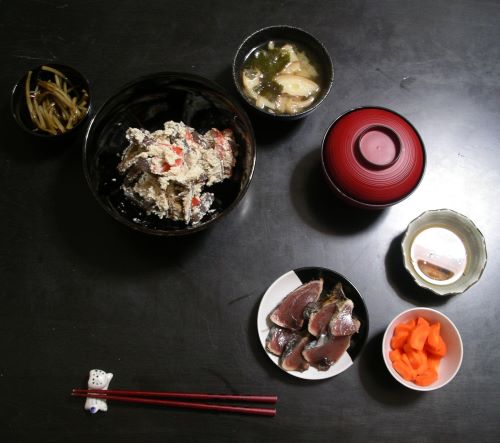 Making the dinner was pretty time-consuming, as was the cleanup. It was totally worth the effort.
Fugu, the pufferfish perhaps best known for its potential lethality as a foodstuff, is in season now. This restaurant is advertising its Fugu Festival. 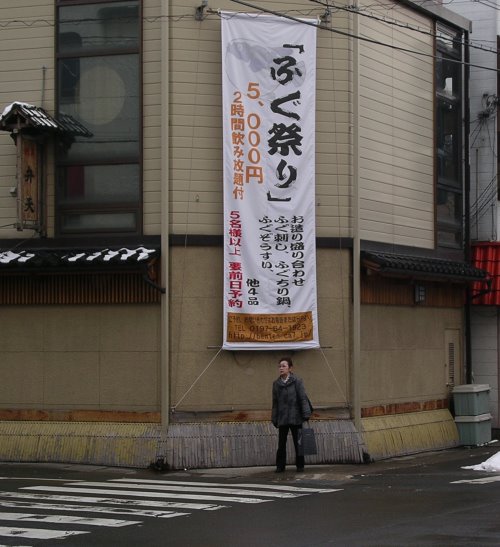 The festival appears to be featuring a sampler of fugu dishes, including fugu sashimi, fugu chirinabe (hotpot), and fugu zousui (rice porridge mixed with soup). There are four other unnamed dishes available as well. It's 5,000 yen for two hours of nomihoudai (all-you-can-drink) and the fugu sampler ― we're passing on this one.
[ 3 comments ] permalink
Many people in Japan, male and female alike, hang multiple small mascots from their keitai (cell phones). Mascots range from characters associated with the phone company to well-known comic, manga, or anime characters. I've only got one on my cute pink phone. 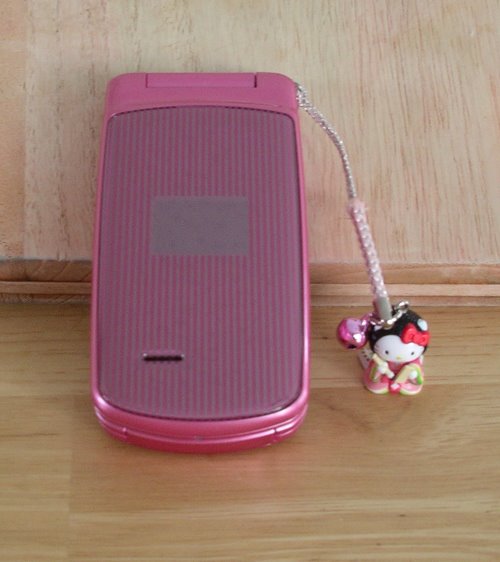 It's Hello Kitty, of course, but she's special. Sanrio makes Hello Kitty merchandise specific to each of the prefectures, representing events or products for which the prefecture is known. This Kitty-chan represents the famous Heian period poetess, Komachi, who according to legend was from what is now Akita Prefecture. Komachi was also regarded as a great beauty, which Matthew thinks makes her name particularly fitting for the Akita Shinkansen. 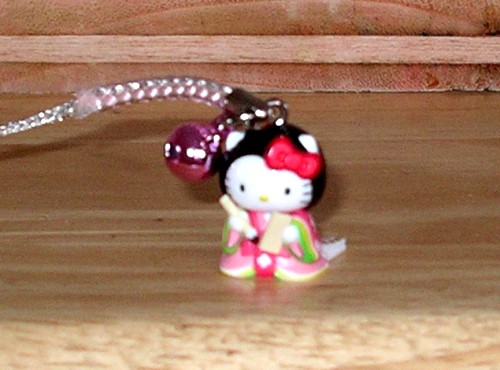
Tuesday, January 8, 2008, 8:27 PM GeneralPosted by stefanie About a month ago, during one of the early snows in Kitakami, I was chatting with a woman who had lived here for many years. We agreed that the weather was quite bleak, then she put on her ganbarimasu! face and said: "Now is the time when Kitakami becomes a frozen city." The mountain gods must have disagreed with that assessment, for that particular snow didn't last very long.
January, it seems, is the time when Kitakami becomes a frozen city. Since New Year's Day, we've had a couple more brief snows that covered the residual snow from that storm. Thin layers of ice cover the snow in the mornings, and bands of ice have spanned the Waga River at times. The snow remains a few inches deep in many spots, which seems to irritate Moki on walks ― he dislikes having to slog through the snow. The roads are mostly cleared, but there are still patches that turn to slush during the day and back to thick sheets of ice at night.
Even more telling was the bit of ice that fell off my Docs in the car during my store run this afternoon. I hopped back into the car after my stop at the grocery, and this ice clump, which apparently fell off en route, hadn't melted AT ALL. Given that, I felt pretty comfortable leaving the fish necks I'd just bought in the car during my kerosene and dog food stop.
According to the weathermen (who are an entirely different blog post), the low in Kitakami this evening is supposed to reach -8 Celsius tonight. Now is the time when we put on our ganbarimasu! faces, throw on another layer of clothes, and discover life in the frozen city.
[ 3 comments ] permalink
Monday, January 7, 2008, 12:38 PM GeneralPosted by matthew We had snow on New Year's Eve and New Year's Day, with enough accumulation that the embankment near our house became attractive to youngsters wanting to sled or build snowmen. And to us, too. On the 2nd, we gave in to temptation and went to play in the snow. Atop the hill there were already two squat Japanese-style (two-ball) snowmen. There was still plenty of snow, so we decided we'd build a western-style snowman with three balls. And not only that, we'd make it huge! To make a big snowman, you need some big snowballs. Of course you have to start small. 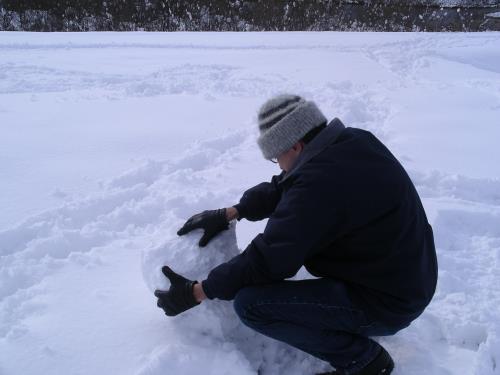 As you roll it around, it gets bigger. You can grow your snowball faster if you don't restrict yourself to rolling up only snow. 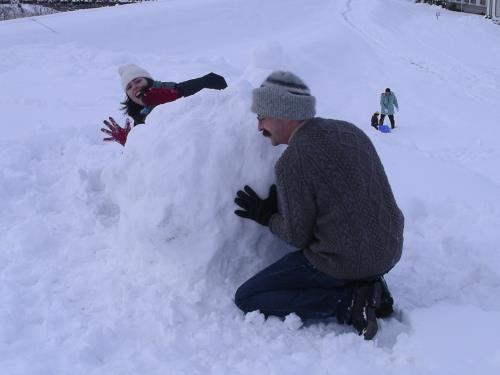 Eventually the snowball got big enough that it took two of us to roll it, then all three of us. We maneuvered it into place to be our snowman base. The torso and head snowballs went much faster, and before long we had a friendly snowman with gravel eyes and wearing Matthew's hat. 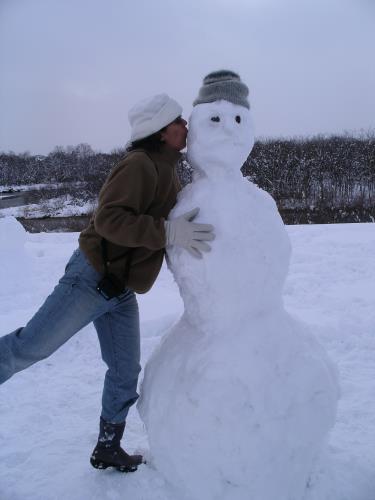 Then Matthew took his hat back. On our way home, we noticed the snowman seemed rather ominous. He towered at the top of the hill, looming over the neighborhood, menacing all with his beady eyes. 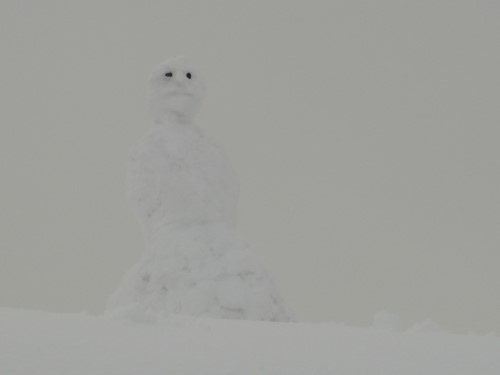 That photo doesn't really capture the feel of it, though. There just wasn't enough contrast between the snowman, ground, and sky. Thanks to the miracle of computers, though, we were able enhance the image so you can see what we mean. 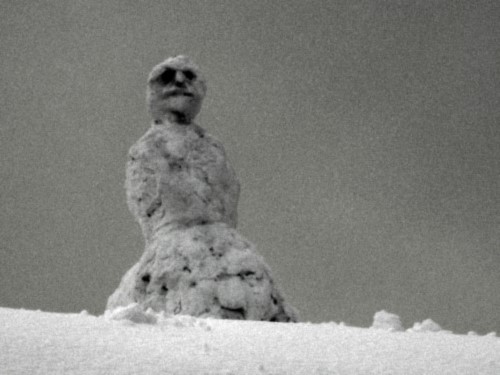 His reign was not to be a long one, though. The next day, some kids took him apart with a shovel and tried to roll the base snowball some more, but found it to be too heavy. For a different account of this adventure, be sure to read Please Take Recess.
[ 4 comments ] permalink
Visiting shrines and temples is an important tradition for New Year's. At large temples, people go on New Year's Eve, and the temple bell sounds 108 times to ring in the new year. Other people arise early, and welcome the new year by visiting a shrine or temple at sunrise. In any case, most people go sometime in the first three days of January. This visit is called hatsumoude. Our nearest shrine, perhaps in recognition that no one wants to be up at dawn in Tohoku in winter, invited the people of the surrounding neigborhoods to visit at 8 am on New Year's Day. We figured this would be a good way to enjoy an old tradition. So, despite our late night the night before, we got up early and made the snowy trek to the shrine grounds. There we found bonfires, friendly greetings, fish paste, and sake. From time to time someone would approach the shrine itself to make an offering and prayer, but mostly it was conversation, drinking, and eating around the bonfires. We ran across several people who remembered us from undoukai. People also wrote their prayers for the new year on paper or wood, which they threw into the fire. The rising smoke carries the prayers up to the gods. 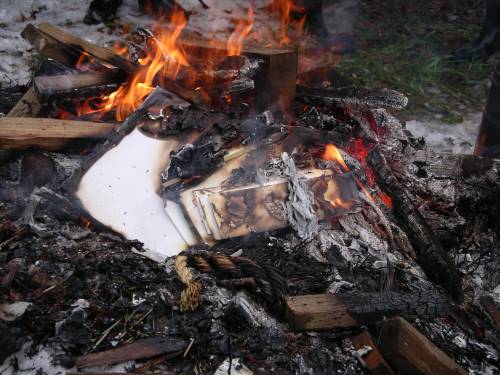 After we were there a short time, a group of men were leaving, and insisted we should go with them. We were uncertain, but they seemed friendly enough, so off we went. Along the way, we learned that our destination was a nearby temple, where there would be more sake, fire, and food. Also along the way, we overheard this exchange (in Japanese): "It's fun bringing the gaikokujin (foreigners) with us." "Don't call them gaikokujin. Call them nakama (good friends)." The temple was one very close to our house, and it was beautiful in the snow. 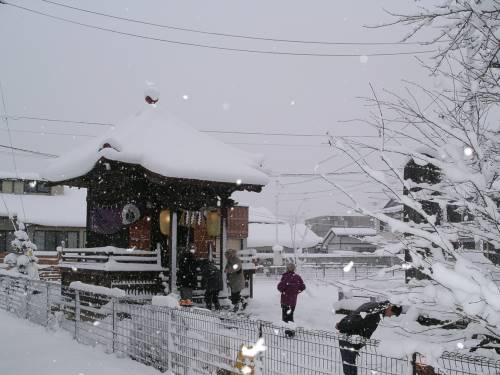 We paid our respects at the altar, then enjoyed more sake along with some snacks, and listened to our new friends speaking in the Tohoku dialect. Before everyone returned home to enjoy osechi ryouri, we got a group photo. 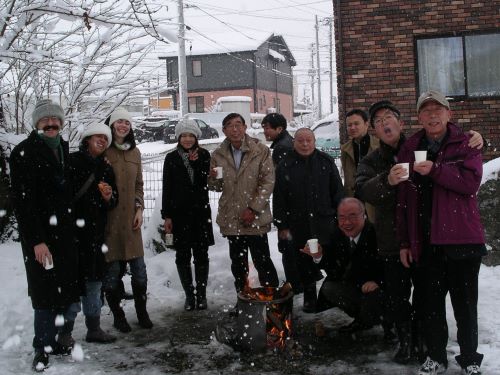 It was an auspicious start to the new year, and left us feeling warm inside.
To make the most of our Japan experience, we've been choosing to participate in Japanese traditions, rituals, and events as much as possible. For New Year's Eve, that would have meant a quiet evening at home and a trip to the temple or shrine at or around midnight. Then a friend told us that there would be a more festive celebration at American World, one involving fireworks. Being Westerners, we like fireworks on New Year's. So, the three of us bundled up for the frigid night ahead and made our way to American World. Much to our relief, events started indoors with a live variety show featuring impersonators of famous Japanese performers. There were also a number of cosplayers (people wearing full costumes of their favorite anime or manga characters). The show was totally fun, and probably would have been even better if we knew the personalities involved. On the other hand, how can you not love seeing a manic guy sing "Livin' La Vida Loca" in Japanese? At one point, an enka song began playing. We knew an impersonator would perform the traditional music, with its themes of love, loss, hardships, and loneliness. We did not, however, expect this: 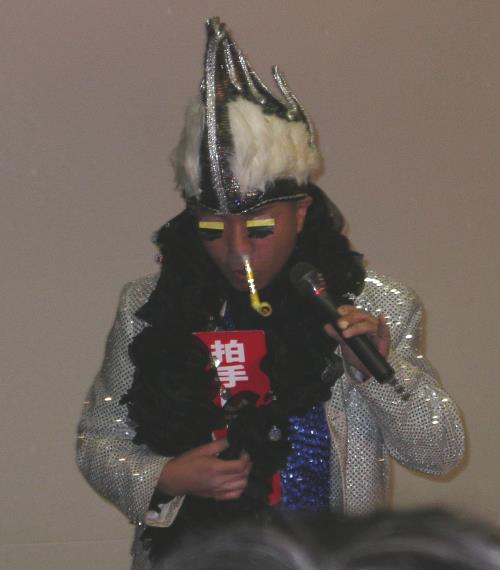 There were also a bunch of people running around in mouse costumes to celebrate the upcoming Year of the Rat/Mouse. It made Matthew feel like he was in a Monty Python sketch. After the show, we were herded outside into the cold, cold, Tohoku night to await the fireworks. About ten minutes into our half-hour wait, organizers started a bonfire in the parking lot ― ahh, blessed heat. I think the girls wearing short-shorts, knee-high socks, and parkas were also grateful for the bonfire. Somewhat inexplicably, there were also a few practice runs for the countdown (in Japanese) to the "Happy New Year" (in English) shout. It must have paid off, because both went off without a hitch. Yay, 2008! Also, yay, fireworks! They were very cool, and much more like an American fireworks display than the two-hour extravaganza for Michinoku Geinou Matsuri (which was good because, well, cold). Fireworks were followed by the organizers tossing balls of mochi into the crowd for good luck. We are not good at catching mochi. Once the events were over, we retired to the house with some local friends. Matthew made amazake, a warm, sweet fermented rice drink, and we ate black sesame and walnut mochi made by the neighbor across the street. Sitting with our feet under the kotatsu with friends new and old, and the dogs lounging nearby, was a perfect way to spend the early moments of the new year, traditional or not.
We've made a calendar of our favorite photos from the blog (and other photos we've taken here), and it's now available for sale! We make $5 off each one — not much, but it does help keep the site running. Just click the "related link" for this entry, or look for the ad over to the right. We now return you to your regular blog blathering.
[ add comment ] permalink
December is the busiest month of the year in Japan. Nengajou need addressing, bonenkai (year-end parties, of which there tend to be many) need attending, and houses receive thorough cleanings. By the time New Year's Day rolls around, people are tired and want some relaxation. Traditionally, families would visit their local shrine to offer prayers for the new year before retiring at home for a day of drinking sake, reading nengajou, and eating osechi ryouri. Osechi ryouri are the traditional New Year's foods. Each food is eaten for a purpose: health, longevity, or wealth, among others. Historically, they are prepared in advance and stored in a large, three-tiered box ( juubako) until New Year's Day; consequently, they tend to be heavily salted, sweetened, or vinegared for preservation purposes. Although people still make osechi at home, you can also buy most of the traditional foods already prepared. We had a small subset of osechi, including some non-traditional treats that had been given to us as gifts earlier in the weekend. 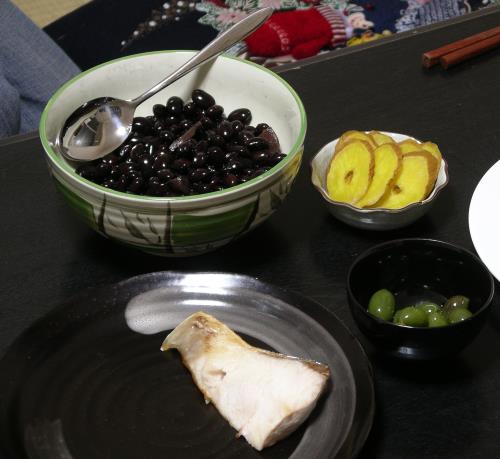 Clockwise from the top left: kuromame (sweetened black beans, eaten for health); iburigakko (smoked pickled daikon radish, an Akita specialty that a friend gave us); Japanese olives (a gift from the same friend); and salt-grilled yellowtail. 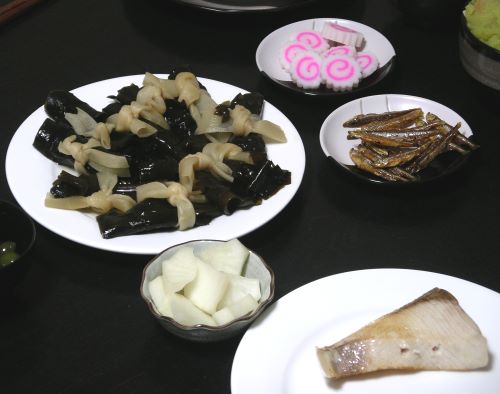 Clockwise from the left: konbumaki (simmered kelp rolls tied with gourd strips, eaten for happiness); kamaboko (fish paste; red and white are auspicious colors for the new year and symbolize celebration); tazukuri (candied sardines, symbolizing an abundant harvest); and rice bran pickled daikon. 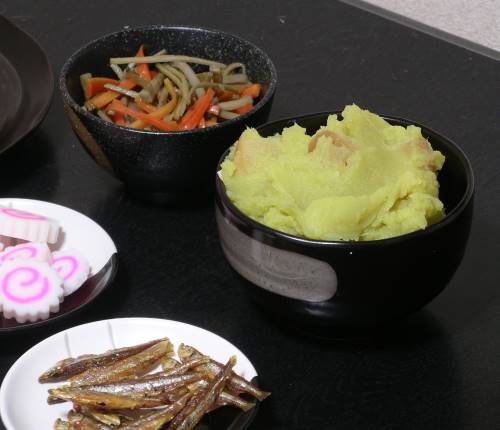 Clockwise from left: another look at the kamaboko; kinpira gobou (simmered burdock root and carrot); ringo kinton (mashed sweet potatoes and apples; eaten to bring good luck); another look at the tazukuri. Not technically part of the osechi, ozouni is also traditionally eaten on New Year's Day. 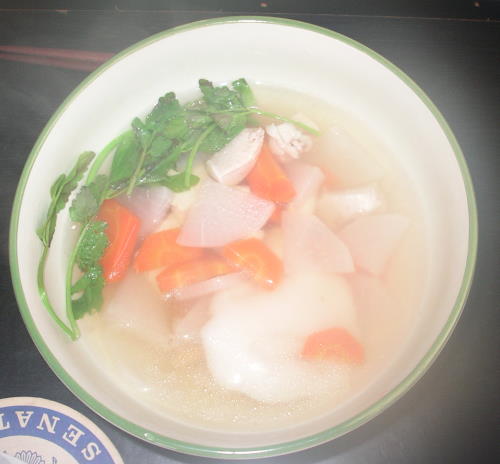 According to our local friends, ozouni in Iwate consists of a clear soup base, chicken, daikon, carrot, ikura (salmon roe), Japanese parsley, and mochi. We had ours for lunch, before a lovely drive to Semi Onsen, where we enjoyed a New Year's soak in the rotenburo, surrounded by two feet of snow.
Back Next
|
|
















 Calendar
Calendar




